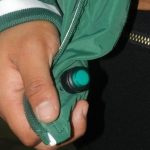Mexico students develop electric shock self-defence coat
Four students in Mexico have developed a jacket they say could protect those wearing it from attacks.
Once armed, the sleeves of the coat can emit an electric shock making anyone holding on to them recoil.
The students say they came up with the idea in light of the high number of sex attacks in their city.
They say the electric shock is low enough for the coat not to be classed as a weapon but strong enough to startle any potential attacker.
The prototype, called Woman Wearable, was developed by mechatronics engineering students Anaid Parra Quiroz and Esthela Gómez, robotics student Giwan Park and law student Guadalupe Martínez.
The four study at the Puebla campus of the Monterrey Institute of Technology and Higher Education and came up with the idea as part of a class in entrepreneurship.
“We’d heard from lots of female friends and acquaintances who had suffered some sort of aggression. After doing some research into gender violence we came up with the idea and then took it from there,” Anaid Parra Quiroz told news agency Conacyt (in Spanish).
How does it work?
The students bought a cotton track suit jacket and inserted into its lining a 9V battery, a transformer, cables which they wrapped so the wearer of the jacket would not be exposed to any current, an on-off button and an LED light.
Robotics student Giwan Park designed the circuit. He explains that the system is activated by the button with the LED light coming on to show it is ready.
Once the system is thus armed, if someone touches the electrodes on the coat’s sleeves, the circuit is closed and an electric shock is delivered to the person touching the electrodes.
The idea is to stun the aggressor, giving the wearer of the jacket time to run away or raise the alarm.
Is it legal?
Law student Guadalupe Martínez joined Woman Wearable to make sure it would not fall foul of the law.
“It’s a self-defence tool,” the student said.
She says that the electric shock administered by the coat is low enough not to pose a threat to life and therefore the jacket does not qualify as a weapon.
What would it cost?
The prototype took the team three months to develop and make. The students say that they would like to further develop it to include sensors and to put the electrodes on more than just the sleeves.
They say that eventually the design could be adapted for other garments such as blouses, skirts and trousers.
The students say they would sell their jacket at around $50 (£40).
IMAGES:
Anaid Parra Quiroz models the coatImage copyright CONACYT
Image caption The coat is fitted with electrodes on its sleeves
A close-up of the button which turns the system onImage copyright CONACYT
Image caption The system is turned on with a a discreetly placed button
A photo by the University of Monterrey showing the four studentsImage copyright ITESM
Image caption Guadalupe, Esthela, Anaid and Giwan came up with the idea.
For more on this story go to: https://www.bbc.com/news/world-latin-america-45207567








